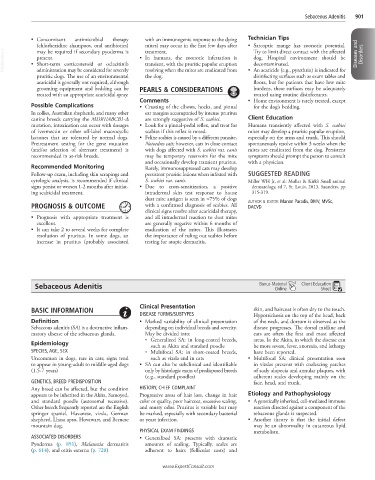Page 1799 - Cote clinical veterinary advisor dogs and cats 4th
P. 1799
Sebaceous Adenitis 901
• Concomitant antimicrobial therapy with an immunogenic response to the dying Technician Tips
(chlorhexidine shampoos, oral antibiotics) mites) may occur in the first few days after • Sarcoptic mange has zoonotic potential.
VetBooks.ir • Short-term corticosteroid or oclacitinib • In humans, the zoonotic infestation is dog. Hospital environment should be Diseases and Disorders
may be required if secondary pyoderma is
treatment.
Try to limit direct contact with the affected
present.
decontaminated.
transient, with the pruritic papular eruption
administration may be considered for severely
disinfecting surfaces such as exam tables and
pruritic dogs. The use of an environmental resolving when the mites are eradicated from • An acaricide (e.g., pyrethrin) is indicated for
the dog.
acaricidal is generally not required, although floors, but for patients that have low mite
grooming equipment and bedding can be PEARLS & CONSIDERATIONS burdens, these surfaces may be adequately
treated with an appropriate acaricidal spray. treated using routine disinfectants.
Comments • Home environment is rarely treated, except
Possible Complications • Crusting of the elbows, hocks, and pinnal for the dog’s bedding.
In collies, Australian shepherds, and many other ear margins accompanied by intense pruritus
canine breeds carrying the MDR1/ABCB1-Δ are strongly suggestive of S. scabiei. Client Education
mutation, intoxication can occur with dosages • Look for a pinnal-pedal reflex, and treat for Humans transiently affected with S. scabiei
of ivermectin or other off-label macrocyclic scabies if this reflex is noted. mites may develop a pruritic papular eruption,
lactones that are tolerated by normal dogs. • Feline scabies is caused by a different parasite, especially on the arms and trunk. This should
Pretreatment testing for the gene mutation Notoedres cati; however, cats in close contact spontaneously resolve within 3 weeks when the
(and/or selection of alternate treatment) is with dogs affected with S. scabiei var. canis mites are eradicated from the dog. Persistent
recommended in at-risk breeds. may be temporary reservoirs for the mite symptoms should prompt the person to consult
and occasionally develop transient pruritus. with a physician.
Recommended Monitoring Rarely, immunosuppressed cats may develop
Follow-up exam, including skin scrapings and persistent pruritic lesions when infested with SUGGESTED READING
cytologic analysis, is recommended if clinical S. scabiei var. canis. Miller WH Jr, et al: Muller & Kirk’s Small animal
signs persist or worsen 1-2 months after initiat- • Due to cross-sensitization, a positive dermatology, ed 7, St. Louis, 2013, Saunders, pp
ing scabicidal treatment. intradermal skin test response to house 315-319.
dust mite antigen is seen in ≈75% of dogs AUTHOR & EDITOR: Manon Paradis, DMV, MVSc,
PROGNOSIS & OUTCOME with a confirmed diagnosis of scabies. All DACVD
clinical signs resolve after acaricidal therapy,
• Prognosis with appropriate treatment is and all intradermal reaction to dust mites
excellent. are generally negative within 6 months of
• It can take 2 to several weeks for complete eradication of the mites. This illustrates
resolution of pruritus. In some dogs, an the importance of ruling out scabies before
increase in pruritus (probably associated testing for atopic dermatitis.
Sebaceous Adenitis Bonus Material Client Education
Sheet
Online
Clinical Presentation
BASIC INFORMATION skin, and haircoat is often dry to the touch.
DISEASE FORMS/SUBTYPES Hypotrichosis on the top of the head, back
Definition • Marked variability of clinical presentation of the neck, and dorsum is observed as the
Sebaceous adenitis (SA) is a destructive inflam- depending on individual breeds and severity. disease progresses. The dorsal midline and
matory disease of the sebaceous glands. May be divided into: ears are often the first and most affected
○ Generalized SA: in long-coated breeds, areas. In the Akita, in which the disease can
Epidemiology such as Akita and standard poodle be more severe, fever, anorexia, and lethargy
SPECIES, AGE, SEX ○ Multifocal SA: in short-coated breeds, have been reported.
Uncommon in dogs, rare in cats; signs tend such as vizsla and in cats • Multifocal SA: clinical presentation seen
to appear in young-adult to middle-aged dogs • SA can also be subclinical and identifiable in vizslas presents with coalescing patches
(1.5-7 years) only by histologic exam of predisposed breeds of scaly alopecia and annular plaques, with
(e.g., standard poodles) adherent scales developing mainly on the
GENETICS, BREED PREDISPOSITION face, head, and trunk.
Any breed can be affected, but the condition HISTORY, CHIEF COMPLAINT
appears to be inherited in the Akita, Samoyed, Progressive areas of hair loss, change in hair Etiology and Pathophysiology
and standard poodle (autosomal recessive). color or quality, poor haircoat, excessive scaling, • A genetically inherited, cell-mediated immune
Other breeds frequently reported are the English and musty odor. Pruritus is variable but may reaction directed against a component of the
springer spaniel, Havanese, vizsla, German be marked, especially with secondary bacterial sebaceous glands is suspected.
shepherd, Lhasa apso, Hovawart, and Bernese or yeast infection. • Another theory is that the initial defect
mountain dog. may be an abnormality in cutaneous lipid
PHYSICAL EXAM FINDINGS metabolism.
ASSOCIATED DISORDERS • Generalized SA: presents with dramatic
Pyoderma (p. 851), Malassezia dermatitis amounts of scaling. Typically, scales are
(p. 614), and otitis externa (p. 728) adherent to hairs (follicular casts) and
www.ExpertConsult.com

